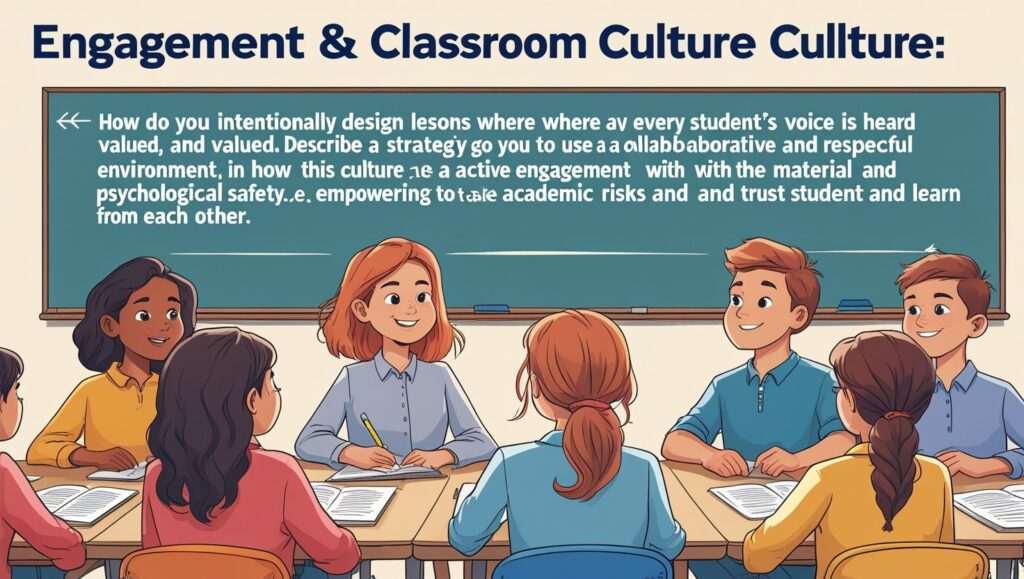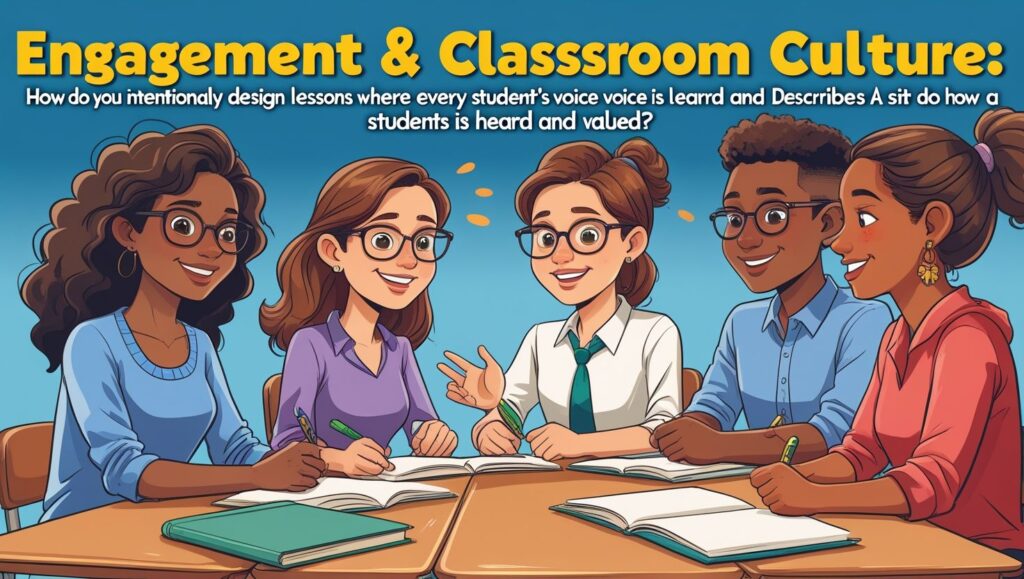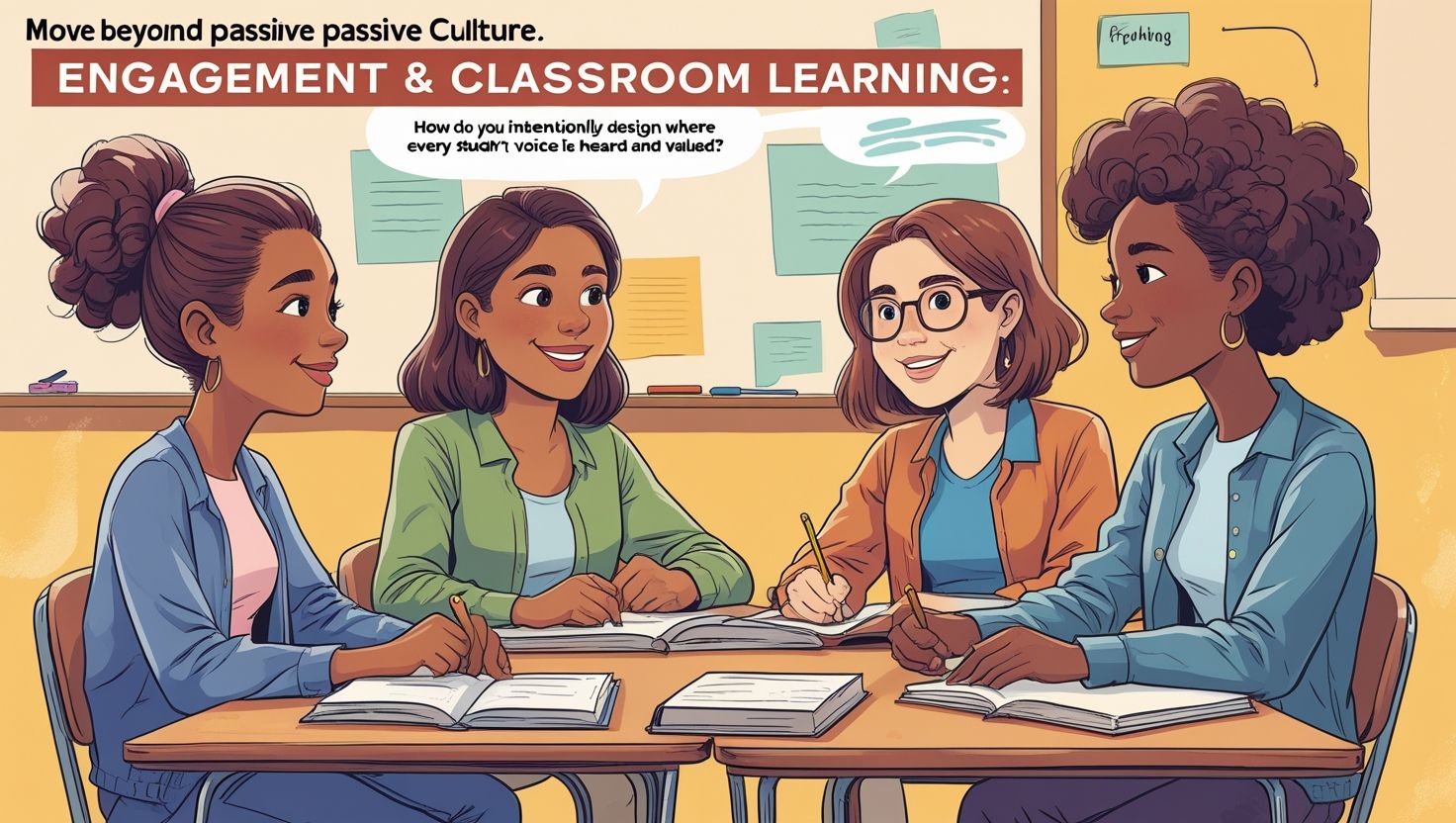Introduction
Engagement and classroom culture play a fundamental role in the success of education. Students learn more effectively when they are fully engaged in lessons and feel comfortable in a positive classroom environment. Engagement refers to the level of attention, curiosity, and interest that students show during learning activities. Classroom culture, on the other hand, reflects the atmosphere, values, and shared practices within the learning space. Both elements are closely connected since active engagement contributes to a strong culture, while a healthy classroom culture promotes deeper engagement. Teachers need to create an environment where students feel safe to express their ideas and participate actively in discussions.
Furthermore, effective classroom culture encourages respect, collaboration, and motivation. It builds a sense of belonging and responsibility among learners. In today’s education, emphasis on these aspects has grown because they directly affect achievement and behavior. Therefore, educators should carefully design strategies to ensure high engagement while also fostering a supportive classroom culture that inspires continuous learning.
Importance of Engagement in Learning
Engagement in learning is vital because it directly influences students’ performance and motivation. When learners actively participate, they are more likely to understand concepts and retain information for longer periods. Engaged students show greater enthusiasm, ask meaningful questions, and take ownership of their learning journey. Moreover, engagement helps reduce distractions, making classroom time more effective and purposeful. Research shows that learners who are deeply engaged are less likely to drop out of school and more likely to achieve their academic goals.
Teachers must adopt techniques such as interactive activities, real-life examples, and group projects to stimulate curiosity and involvement. Additionally, emotional engagement, such as feeling valued and respected, strengthens students’ connection with the subject and the teacher. Without engagement, classrooms can become passive, leading to low motivation and poor results. Therefore, promoting engagement is not only beneficial for academic success but also for building lifelong learners. It helps in developing problem-solving skills, creativity, and confidence among students.
Building Classroom Culture
Creating a strong classroom culture is essential to support both academic and personal growth. Classroom culture sets the tone for how students interact, communicate, and collaborate with each other. A positive culture promotes respect, inclusivity, and responsibility. Teachers need to establish clear expectations from the beginning to guide behavior and attitudes. When students know the values of their classroom, they are more likely to act respectfully and contribute positively. In addition, a strong classroom culture helps reduce conflicts and fosters cooperation. Students feel more comfortable sharing their thoughts and learning from peers.
It also builds trust between teachers and learners, which is vital for open communication. Furthermore, classroom culture should celebrate diversity and allow students to learn from different perspectives. Teachers can create this culture through consistent routines, recognition of achievements, and modeling respectful behavior. A healthy culture enhances learning outcomes by making students feel secure, motivated, and part of a community where their contributions are valued.

Teacher’s Role in Engagement
The teacher’s role in engagement is central because educators serve as facilitators of learning. Teachers must design lessons that capture attention and stimulate curiosity. They can achieve this through interactive methods such as discussions, multimedia resources, and practical activities. Teachers also need to adapt their teaching style according to students’ needs and learning preferences. By showing enthusiasm for the subject, teachers inspire students to develop similar interest. Furthermore, teachers should provide feedback that encourages improvement and motivates learners. Engagement also depends on building positive teacher-student relationships.
When students feel that their teacher cares about their success, they are more likely to participate actively. Another important role of teachers is creating inclusive environments where every student’s voice is heard. Teachers must balance discipline with encouragement to maintain focus while supporting creativity. By constantly reflecting on their strategies, teachers can find new ways to enhance engagement. Thus, teachers act as the foundation for building motivation, curiosity, and active participation in the classroom.
Student’s Role in Engagement
Students also play a key role in maintaining engagement. Although teachers create opportunities, it is the responsibility of learners to take advantage of them. Students must develop self-motivation and responsibility for their learning progress. Active participation, asking questions, and collaborating with peers are important contributions to classroom engagement. Moreover, students should practice good listening and respect for others’ opinions to maintain a healthy learning environment.
Engagement requires learners to stay curious and open-minded. When students connect lessons to their real-life experiences, they become more invested in learning. Peer interaction is another vital element since students learn from group discussions, debates, and teamwork. In addition, learners must adopt positive attitudes toward challenges instead of avoiding them. Taking risks, sharing ideas, and experimenting with different solutions are essential for growth. Although distractions are common, engaged students learn to manage them by focusing on their goals. Therefore, students have an equally significant role in shaping the overall level of engagement within the classroom culture.
Strategies to Promote Engagement
Promoting engagement requires a variety of teaching strategies that address diverse learning needs. Teachers can use interactive activities such as group projects, role plays, and problem-solving tasks to keep students actively involved. Technology can also play a vital role in increasing engagement. Digital tools like presentations, videos, and online quizzes make lessons more dynamic. Additionally, teachers should incorporate real-world examples to connect abstract concepts with practical life. Another effective strategy is differentiated instruction, which adapts lessons to various learning styles and abilities. Providing choices in assignments encourages students to take ownership of their work.
Moreover, frequent feedback helps learners understand their strengths and areas for improvement. Teachers should also promote inquiry-based learning, where students ask questions and explore solutions independently. Encouraging reflection allows students to evaluate their own learning journey. Finally, maintaining a balance between fun and challenge helps sustain interest. These strategies together ensure that students remain active participants in the classroom environment.

Role of Classroom Culture in Discipline
Classroom culture plays a critical role in managing discipline effectively. When a positive culture is established, students naturally follow rules and expectations. Instead of strict punishments, the focus shifts toward mutual respect and responsibility. Students in a strong classroom culture understand that their actions affect others. As a result, they make more thoughtful decisions. Discipline becomes less about control and more about cooperation. Teachers set boundaries while allowing freedom for creativity and expression.
Peer influence also contributes to discipline because students hold each other accountable in a respectful environment. Furthermore, a supportive culture reduces negative behaviors such as bullying, disruption, or disobedience. Students feel valued, which lowers the need to seek attention through misbehavior. Clear communication and consistent routines also promote discipline as part of classroom culture. Importantly, discipline should encourage learning from mistakes rather than creating fear. In this way, classroom culture transforms discipline into a shared responsibility that promotes harmony and effective learning.
Collaboration and Group Learning
Collaboration and group learning are powerful aspects of engagement and classroom culture. Working together allows students to share ideas, challenge assumptions, and solve problems collectively. It promotes social skills, teamwork, and respect for diverse perspectives. In addition, collaborative learning keeps students engaged because they become active contributors rather than passive listeners. Group projects encourage responsibility, as each member plays a role in achieving a common goal. Teachers can design activities where students learn from one another, such as peer tutoring or cooperative assignments. This approach builds confidence and enhances communication skills.
Moreover, group learning supports classroom culture by creating a sense of community and belonging. Students learn to negotiate, compromise, and resolve conflicts constructively. It also prepares learners for real-world situations where collaboration is essential. By engaging in group activities, students become more motivated and committed. Therefore, collaboration strengthens both engagement and classroom culture while ensuring that learning is meaningful and interactive.
Technology and Engagement
Technology has become a powerful tool for boosting engagement in education. Digital platforms, interactive applications, and multimedia resources make learning more appealing and accessible. Students can explore concepts visually, practice skills through simulations, and participate in online discussions. Furthermore, technology allows teachers to personalize learning experiences based on individual needs. For example, adaptive learning software adjusts the level of difficulty according to student performance.
Technology also supports creativity by enabling learners to design presentations, videos, or digital projects. In addition, it connects classroom learning to real-world contexts through virtual tours or global collaborations. Teachers must use technology strategically, ensuring that it enhances rather than distracts from learning. Digital tools should be balanced with face-to-face interaction to maintain strong classroom culture. When used effectively, technology promotes engagement by making lessons interactive, flexible, and exciting. Therefore, it serves as a bridge between traditional teaching methods and modern learning needs.
Conclusion
Engagement and classroom culture are inseparable elements that shape the quality of education. Engagement ensures that students are active participants in their learning journey, while classroom culture provides the supportive environment necessary for success. Teachers and students both play vital roles in maintaining these elements. Effective strategies, including interactive activities, collaboration, and the use of technology, help in promoting sustained interest. Classroom culture also contributes to discipline and builds a sense of belonging, respect, and cooperation.
Together, these factors create an atmosphere where learning becomes meaningful and enjoyable. In the modern world, where education faces challenges of distraction and lack of motivation, engagement and culture act as solutions. Schools must prioritize them to ensure academic achievement as well as personal growth. By valuing engagement and nurturing classroom culture, educators prepare students not only for exams but also for life. Ultimately, these elements foster confidence, curiosity, and lifelong learning in every student.

n3mujl
fw7wl2
I hardlky drop comments, but i did some searching and wound up here Engagement & Classeoom Culture
in Education – Teacher's Guide. And I actually do have
a few questions ffor you if it’s allright. Is it simply me or does
it look as if like a few of the responses come across like they
are coming from brain dead folks? 😛 And,
if youu are posting aat additional places, I’d like to follow everything fresh you have to post.
Could you make a list of the complete urls of your public pages like your twitter feed, Facebook page oor linkedin profile? https://Glassi-india.mystrikingly.com/